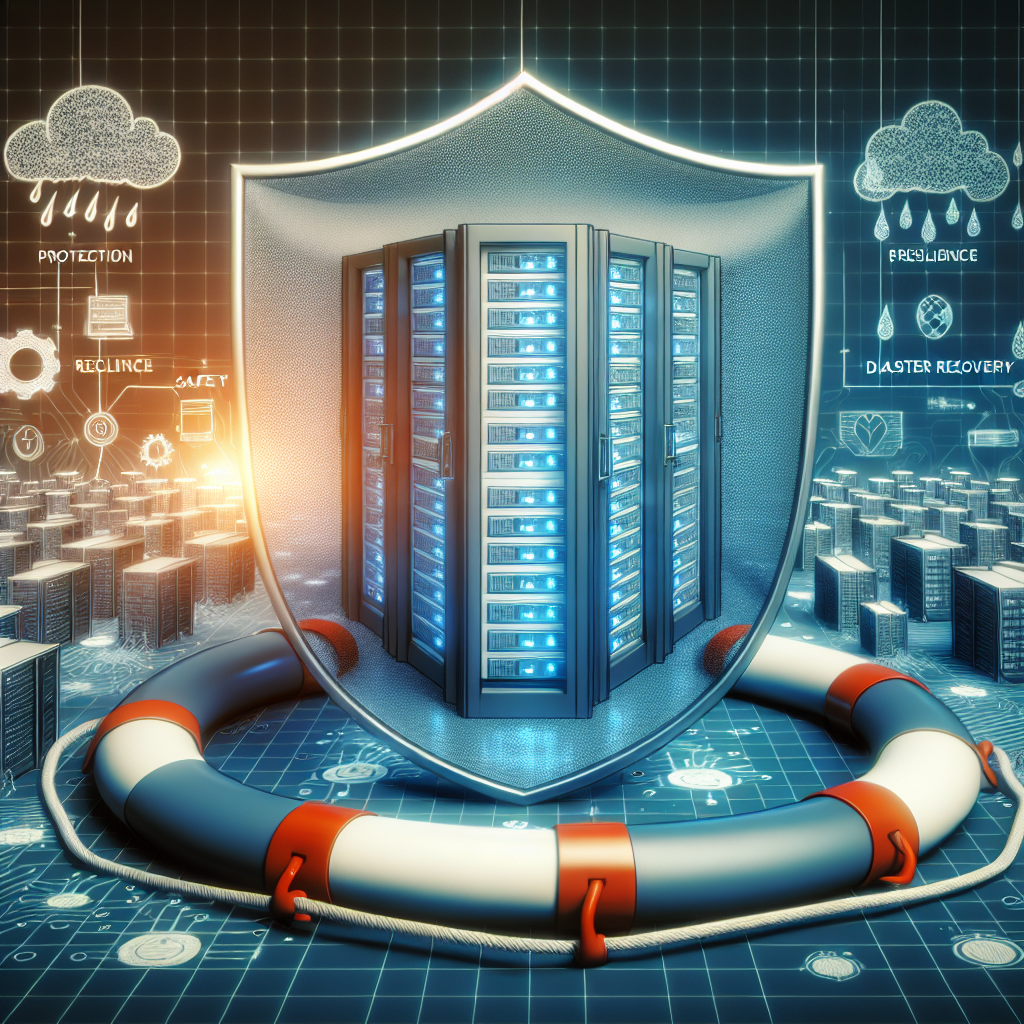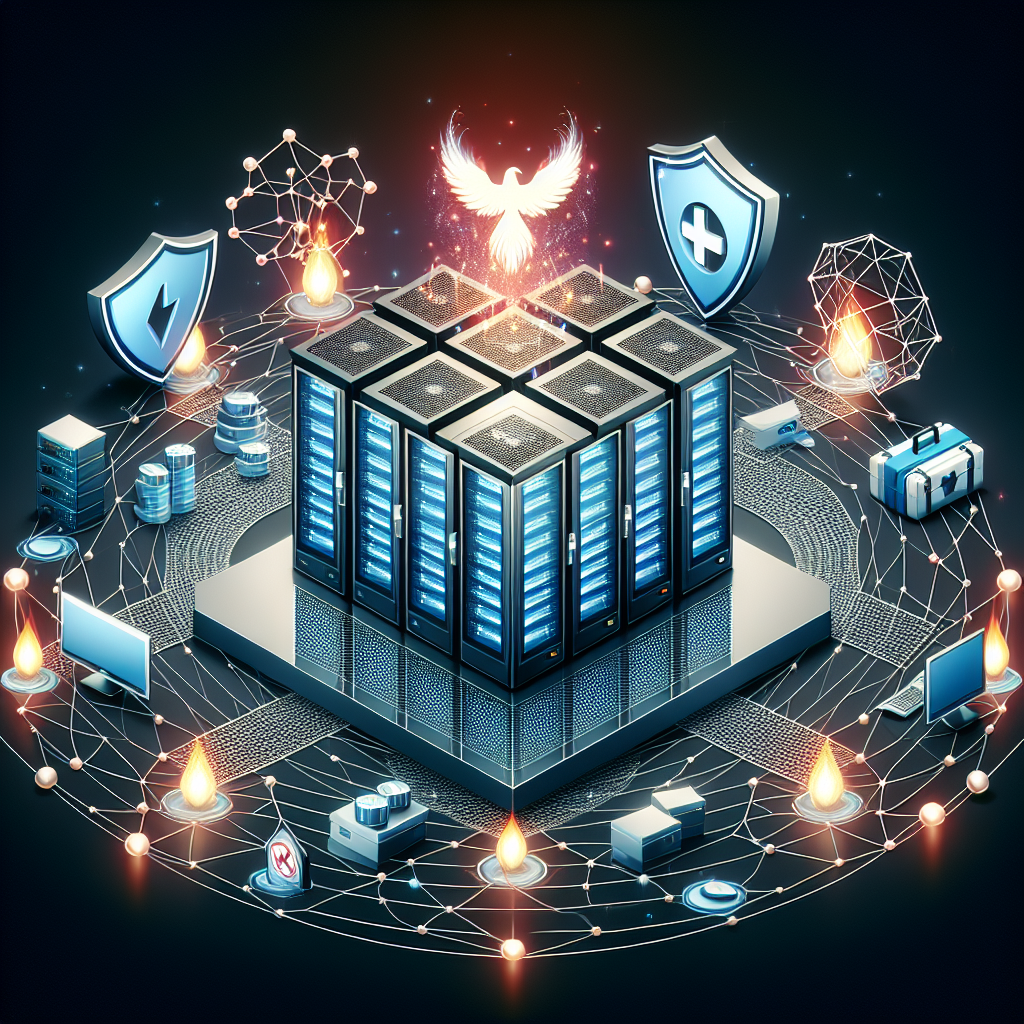Your cart is currently empty!
Tag: Data Center Disaster Recovery

Data Center Disaster Recovery: Strategies for Business Continuity
In today’s digital age, data is the lifeblood of businesses. From customer information to financial records, companies rely on data to operate efficiently and effectively. However, what happens when a disaster strikes and critical data is lost or inaccessible? This is where disaster recovery strategies come into play.Data center disaster recovery is the process of planning for and recovering from a disaster that affects a company’s data center. This could be anything from a natural disaster like a hurricane or earthquake, to a cyber attack or hardware failure. Regardless of the cause, having a solid disaster recovery plan in place is essential for ensuring business continuity and minimizing downtime.
There are several key strategies that businesses can implement to ensure their data centers are prepared for a disaster:
1. Backup and Recovery: One of the most basic but essential components of a disaster recovery plan is regular data backups. This involves making copies of critical data and storing them in a secure location, either on-site or off-site. In the event of a disaster, these backups can be used to restore data and get systems back up and running quickly.
2. Redundancy: Redundancy is the practice of having multiple systems or components in place to ensure continuity in case of a failure. This could include redundant power supplies, network connections, or even entire data centers. By having redundancy in place, businesses can minimize the impact of a disaster on their operations.
3. Disaster Recovery Testing: It’s not enough to simply have a disaster recovery plan in place – it’s important to regularly test and update it to ensure it will work when needed. This could involve running simulated disaster scenarios, conducting regular data recovery drills, or performing audits of the plan to identify any weaknesses or gaps.
4. Cloud-based Backup: Cloud-based backup solutions offer a convenient and cost-effective way to store critical data off-site. By leveraging the cloud, businesses can access their data from anywhere and ensure it is protected in the event of a disaster.
5. Disaster Recovery as a Service (DRaaS): DRaaS is a service that provides businesses with a comprehensive disaster recovery solution, including backup, recovery, and failover capabilities. By outsourcing disaster recovery to a third-party provider, businesses can ensure their data is protected and their systems are back up and running quickly in the event of a disaster.
In conclusion, data center disaster recovery is a critical component of business continuity planning. By implementing the right strategies and technologies, businesses can ensure their data is protected and their operations can continue in the face of a disaster. Don’t wait until it’s too late – start planning for disaster recovery today.

Preparing for the Worst: A Guide to Data Center Disaster Recovery
In today’s digital age, data centers are the backbone of many businesses, storing and processing vast amounts of critical information. However, with the increasing frequency of natural disasters, cyber-attacks, and system failures, it is more important than ever for organizations to have a comprehensive disaster recovery plan in place to protect their data and ensure business continuity.Preparing for the worst means having a solid disaster recovery strategy in place that can quickly and effectively restore operations in the event of a catastrophic event. This guide will outline the key steps to take in order to prepare your data center for any disaster:
1. Conduct a Risk Assessment: The first step in preparing for a disaster is to assess the potential risks that could impact your data center. This includes identifying potential threats such as natural disasters, cyber-attacks, hardware failures, and human error. By understanding the potential risks, you can prioritize your disaster recovery efforts and allocate resources accordingly.
2. Develop a Disaster Recovery Plan: Once you have identified the potential risks, it is important to develop a detailed disaster recovery plan that outlines the steps to take in the event of a disaster. This plan should include a clear chain of command, contact information for key personnel, and detailed procedures for restoring operations.
3. Implement Redundant Systems: To minimize downtime in the event of a disaster, it is important to implement redundant systems in your data center. This includes redundant power supplies, network connections, and storage devices. By having redundant systems in place, you can ensure that your data center remains operational even in the event of a hardware failure.
4. Backup Data Regularly: One of the most important steps in disaster recovery is to regularly backup your data. This includes both on-site and off-site backups to ensure that your data is protected in the event of a disaster. It is important to test your backups regularly to ensure that they can be restored quickly and accurately.
5. Train Your Staff: In the event of a disaster, your staff will play a critical role in restoring operations. It is important to train your staff on the disaster recovery plan and ensure that they understand their roles and responsibilities. This includes conducting regular drills and exercises to test the effectiveness of your disaster recovery plan.
6. Monitor and Update Your Plan: Disaster recovery planning is an ongoing process that requires regular monitoring and updates. It is important to regularly review and update your disaster recovery plan to ensure that it remains effective in the face of changing threats and technologies.
By following these key steps, you can ensure that your data center is prepared for the worst and can quickly recover from any disaster. Remember, disaster recovery planning is an investment in the future of your business, so take the time to develop a comprehensive plan that will protect your data and ensure business continuity.

Navigating Data Center Disaster Recovery in a Cybersecurity Landscape
In today’s digital age, data centers play a critical role in the operations of businesses and organizations. With the increasing reliance on technology, the importance of data center disaster recovery has become paramount in ensuring business continuity and safeguarding valuable information.In a cybersecurity landscape where cyber threats and attacks are constantly evolving, data center disaster recovery is crucial for protecting sensitive data and minimizing downtime in the event of a disaster. Whether it be natural disasters, hardware failures, or cyberattacks, having a comprehensive disaster recovery plan in place is essential for mitigating risks and ensuring smooth operations.
Navigating data center disaster recovery in a cybersecurity landscape can be complex, but with the right strategies and protocols in place, organizations can effectively manage and mitigate risks. Here are some key considerations to keep in mind when developing a data center disaster recovery plan:
1. Risk assessment: Conduct a thorough risk assessment to identify potential threats and vulnerabilities to your data center. This will help in understanding the potential impact of disasters and prioritize resources accordingly.
2. Backup and recovery solutions: Implement robust backup and recovery solutions to ensure that data is regularly backed up and can be quickly restored in the event of a disaster. Utilize cloud-based backup solutions for added security and redundancy.
3. Disaster recovery testing: Regularly test your disaster recovery plan to ensure that it is effective and can be executed efficiently in case of an emergency. Conducting drills and simulations will help in identifying gaps and weaknesses in the plan.
4. Data encryption and security: Implement strong encryption protocols to protect sensitive data from unauthorized access. Utilize multi-factor authentication and access controls to prevent data breaches and cyberattacks.
5. Disaster recovery team: Establish a dedicated disaster recovery team with clear roles and responsibilities. Ensure that team members are trained and equipped to respond effectively in case of an emergency.
6. Communication plan: Develop a communication plan to ensure that stakeholders are informed and updated during a disaster. Establish communication channels and protocols for timely and accurate information dissemination.
In conclusion, navigating data center disaster recovery in a cybersecurity landscape requires a proactive and strategic approach. By implementing robust backup and recovery solutions, conducting regular testing, and prioritizing data security, organizations can effectively mitigate risks and ensure business continuity in the face of disasters. With a comprehensive disaster recovery plan in place, businesses can confidently navigate the challenges of the cybersecurity landscape and safeguard their valuable data.

How to Implement a Successful Data Center Disaster Recovery Strategy
In today’s digital age, data centers play a crucial role in storing and managing vast amounts of data for businesses of all sizes. However, with the increasing reliance on data centers, the risk of disasters that could potentially disrupt operations has also grown. In order to protect their data and ensure business continuity, organizations must have a robust disaster recovery strategy in place.Implementing a successful data center disaster recovery strategy involves a combination of planning, technology, and processes. Here are some key steps to help organizations create an effective disaster recovery plan:
1. Identify potential risks: The first step in creating a disaster recovery strategy is to identify potential risks that could impact the data center, such as natural disasters, cyber-attacks, hardware failures, or human error. By understanding these risks, organizations can develop a plan to mitigate and respond to them effectively.
2. Define recovery objectives: Once risks have been identified, organizations should define their recovery objectives, including recovery time objectives (RTOs) and recovery point objectives (RPOs). RTOs refer to the maximum amount of time it takes to restore operations after a disaster, while RPOs refer to the maximum amount of data that can be lost in the event of a disaster.
3. Implement data backup and replication solutions: Data backup and replication are essential components of a disaster recovery strategy. Organizations should implement solutions that enable them to back up data regularly and replicate it to an offsite location. This ensures that data can be recovered quickly in the event of a disaster.
4. Test the disaster recovery plan: It is crucial to regularly test the disaster recovery plan to ensure that it is effective and can be executed successfully in the event of a disaster. Testing should include simulating various disaster scenarios and verifying that data can be recovered within the defined RTOs and RPOs.
5. Train staff: Employees play a critical role in implementing a successful disaster recovery strategy. Organizations should provide training to staff on their roles and responsibilities during a disaster, as well as conduct regular drills to ensure that everyone is prepared to respond effectively.
6. Monitor and update the plan: Disaster recovery plans should be regularly monitored and updated to reflect changes in technology, infrastructure, or business requirements. Organizations should also review and revise the plan after any major incidents to incorporate lessons learned and improve resilience.
By following these steps and implementing a comprehensive disaster recovery strategy, organizations can minimize the impact of disasters on their data center operations and protect their valuable data. Investing in disaster recovery planning is essential for ensuring business continuity and safeguarding the reputation and financial stability of the organization.

Data Center Disaster Recovery: Ensuring Business Continuity in a Digital World
In today’s digital age, data centers play a crucial role in storing and managing the vast amounts of data that organizations rely on to operate their businesses. From customer information to financial records, data centers are essential for maintaining business continuity and ensuring that operations run smoothly. However, with the increasing reliance on technology, the risk of data center disasters has also grown, making disaster recovery planning a critical component of any organization’s IT strategy.Data center disasters can be caused by a variety of factors, including natural disasters such as earthquakes, hurricanes, and floods, as well as man-made events like cyber-attacks, power outages, and equipment failures. When a disaster strikes, the consequences can be catastrophic, resulting in downtime, data loss, and financial losses for the organization.
To mitigate the impact of data center disasters and ensure business continuity, organizations need to have a comprehensive disaster recovery plan in place. This plan should outline the steps to be taken in the event of a disaster, including how data will be backed up, restored, and recovered, as well as how communication will be managed with employees, customers, and other stakeholders.
One key aspect of data center disaster recovery is data backup and replication. Organizations should regularly back up their data to offsite locations to ensure that it is protected in the event of a disaster. Additionally, data replication can help ensure that data is available and accessible even if one data center goes down.
Another important consideration in data center disaster recovery is testing and training. Organizations should regularly test their disaster recovery plan to ensure that it is effective and up to date. In addition, employees should be trained on the plan and their roles and responsibilities in the event of a disaster.
Cloud computing can also play a significant role in data center disaster recovery. By leveraging the cloud, organizations can store data offsite, enabling them to quickly and easily recover data in the event of a disaster. Additionally, cloud-based disaster recovery solutions can provide greater flexibility and scalability compared to traditional on-premises solutions.
In conclusion, data center disaster recovery is essential for ensuring business continuity in a digital world. By having a comprehensive disaster recovery plan in place that includes data backup and replication, testing and training, and leveraging cloud computing, organizations can minimize the impact of data center disasters and ensure that their operations continue to run smoothly. In today’s fast-paced and technology-driven world, disaster recovery planning is more important than ever to protect organizations from the potentially devastating consequences of data center disasters.

Preparing for the Unexpected: Implementing a Data Center Disaster Recovery Plan
In today’s digital age, data centers are at the heart of most businesses’ operations. From storing crucial information to running essential applications, data centers play a critical role in keeping organizations up and running. However, as with any technology, data centers are not immune to disasters. Whether it’s a natural disaster like a hurricane or a man-made event like a cyberattack, data centers can be vulnerable to various threats that could jeopardize the integrity of the data stored within.That’s why it’s essential for businesses to have a robust disaster recovery plan in place to ensure that they can quickly recover their data and resume operations in the event of a disaster. A data center disaster recovery plan is a comprehensive strategy that outlines the steps to be taken to safeguard data and ensure business continuity in the face of a disaster. Here are some key steps to consider when implementing a data center disaster recovery plan:
1. Assess Risks: The first step in creating a data center disaster recovery plan is to assess the potential risks that could impact the data center. This includes identifying potential threats such as natural disasters, cyberattacks, equipment failures, and human error.
2. Define Recovery Objectives: Once the risks have been identified, it’s essential to define the recovery objectives. This includes determining the maximum tolerable downtime for each application or system and setting recovery time objectives (RTO) and recovery point objectives (RPO) for each.
3. Develop a Recovery Strategy: Based on the recovery objectives, develop a comprehensive recovery strategy that outlines the steps to be taken in the event of a disaster. This may include backup and recovery procedures, failover systems, and communication plans.
4. Test the Plan: It’s crucial to regularly test the data center disaster recovery plan to ensure that it is effective and can be implemented quickly in the event of a disaster. This may involve conducting simulated disaster scenarios or tabletop exercises.
5. Establish Communication Protocols: In the event of a disaster, clear communication is essential to ensure that all stakeholders are informed and can take appropriate action. Establish communication protocols that outline how information will be shared and who will be responsible for communicating with key stakeholders.
6. Implement Redundancy: To minimize the risk of data loss, consider implementing redundancy in critical systems and applications. This could include redundant power supplies, backup servers, and off-site data storage.
By following these steps and implementing a robust data center disaster recovery plan, businesses can better prepare for the unexpected and ensure that they can quickly recover their data and resume operations in the event of a disaster. Don’t wait until it’s too late – start preparing for the unexpected today.

Data Center Disaster Recovery: A Key Component of IT Resilience
In today’s digital age, data has become one of the most valuable assets for businesses. From customer information to financial records, companies rely on their data to operate efficiently and effectively. However, with the increasing amount of data being generated and stored, the risk of data loss due to disasters has also increased.Data center disaster recovery is a key component of IT resilience that ensures a company’s critical data and applications are protected and can be quickly restored in the event of a disaster. Whether it’s a natural disaster like a hurricane or earthquake, or a man-made disaster such as a cyber attack or hardware failure, having a robust disaster recovery plan in place is essential to minimize downtime and ensure business continuity.
There are several key components of data center disaster recovery that businesses should consider when developing their disaster recovery plan. These include:
1. Backup and replication: One of the most important aspects of disaster recovery is having regular backups of your data and applications. This ensures that even if your primary data center is compromised, you have a copy of your data stored offsite that can be quickly restored. Additionally, replication technology can help ensure that your data is continuously copied to another location in real-time, reducing the risk of data loss.
2. High availability: To ensure business continuity, it’s important to have redundant systems in place that can quickly take over in the event of a failure. This can include failover systems, redundant power supplies, and network connections to ensure that your critical systems are always available.
3. Disaster recovery testing: It’s not enough to have a disaster recovery plan in place – it’s important to regularly test and update your plan to ensure it will work when needed. Regular testing can help identify any weaknesses in your plan and ensure that your data can be quickly restored in the event of a disaster.
4. Cloud-based disaster recovery: With the rise of cloud computing, many companies are now turning to cloud-based disaster recovery solutions. These solutions offer greater flexibility and scalability, allowing businesses to quickly scale their disaster recovery capabilities as needed. Additionally, cloud-based solutions can often be more cost-effective than traditional on-premises solutions.
Overall, data center disaster recovery is a crucial component of IT resilience that businesses cannot afford to overlook. By implementing a robust disaster recovery plan that includes regular backups, high availability systems, disaster recovery testing, and cloud-based solutions, companies can ensure that their critical data and applications are protected and can be quickly restored in the event of a disaster. Investing in data center disaster recovery is not only essential for protecting your business, but it can also give you a competitive edge in today’s fast-paced and data-driven business environment.

Mitigating Risks: Strategies for Data Center Disaster Recovery
In today’s digital age, data centers play a crucial role in storing and managing vast amounts of information for businesses and organizations. However, with the increasing reliance on data centers, the need for effective disaster recovery strategies has become more important than ever. This is because data center outages can have severe consequences, including financial losses, reputational damage, and even legal implications.Mitigating risks and ensuring the continuity of operations in the event of a disaster is essential for any organization that relies on data centers. Here are some strategies for data center disaster recovery that can help mitigate risks and ensure business continuity:
1. Develop a comprehensive disaster recovery plan: The first step in mitigating risks is to develop a comprehensive disaster recovery plan that outlines the steps to be taken in the event of a data center outage. This plan should include a thorough assessment of potential risks, as well as detailed procedures for data backup, recovery, and restoration.
2. Implement a robust backup and recovery system: One of the most critical components of a disaster recovery plan is a robust backup and recovery system. Regularly backing up data and storing it in multiple locations, both on-site and off-site, can help minimize the impact of a data center outage and ensure quick recovery in the event of a disaster.
3. Test your disaster recovery plan regularly: Testing your disaster recovery plan regularly is crucial to ensure its effectiveness. Conducting regular drills and simulations can help identify any weaknesses in the plan and allow for adjustments to be made before a real disaster strikes.
4. Implement redundancy and failover systems: Redundancy and failover systems can help minimize the impact of a data center outage by providing backup resources and alternative pathways for data transfer. By implementing redundant systems and failover mechanisms, organizations can ensure the continuity of operations even in the event of a disaster.
5. Monitor and update your disaster recovery plan: Monitoring and updating your disaster recovery plan regularly is essential to ensure its effectiveness. As technology and business needs evolve, it’s crucial to review and revise your disaster recovery plan to address any new risks or vulnerabilities that may arise.
In conclusion, mitigating risks and ensuring the continuity of operations in the event of a data center disaster is essential for any organization that relies on data centers. By developing a comprehensive disaster recovery plan, implementing robust backup and recovery systems, testing the plan regularly, implementing redundancy and failover systems, and monitoring and updating the plan, organizations can minimize the impact of a data center outage and ensure business continuity in the face of a disaster.

The Evolution of Data Center Disaster Recovery in a Digital World
In today’s digital age, data centers play a crucial role in storing, managing, and processing vast amounts of data. With the increasing reliance on technology for business operations, the need for robust disaster recovery plans for data centers has become more important than ever before.The evolution of data center disaster recovery has been driven by advancements in technology, changes in business requirements, and a growing awareness of the potential risks and consequences of data loss. In the past, disaster recovery plans were often limited to creating backups of data and storing them offsite. However, as data centers have become more complex and interconnected, traditional backup solutions are no longer sufficient to ensure data protection in the event of a disaster.
Today, data center disaster recovery involves a multi-faceted approach that combines backup and recovery solutions with real-time monitoring, automated failover systems, and redundant infrastructure. These measures are designed to minimize downtime, ensure data integrity, and maintain business continuity in the face of natural disasters, cyber attacks, hardware failures, and other unforeseen events.
One of the key trends in data center disaster recovery is the adoption of cloud-based solutions. Cloud-based disaster recovery services offer greater flexibility, scalability, and cost-effectiveness compared to traditional on-premises solutions. By leveraging the cloud, organizations can quickly recover their data and applications in the event of a disaster, without the need for expensive hardware investments or complex recovery procedures.
Another important trend in data center disaster recovery is the use of virtualization technology. Virtualization allows organizations to create virtual replicas of their data centers, which can be easily replicated and deployed in the event of a disaster. This enables organizations to quickly recover their IT systems and applications, minimizing downtime and ensuring business continuity.
In addition to technological advancements, the evolution of data center disaster recovery has also been influenced by changes in regulatory requirements and industry standards. Many organizations are now required to comply with data protection regulations such as GDPR, HIPAA, and PCI DSS, which mandate the implementation of robust disaster recovery plans to protect sensitive data and ensure data security.
Overall, the evolution of data center disaster recovery in a digital world has been driven by the need for greater resilience, flexibility, and efficiency in the face of increasing data volumes, cyber threats, and regulatory requirements. By adopting a comprehensive disaster recovery strategy that leverages the latest technologies and best practices, organizations can ensure the safety and security of their data, and maintain business continuity in the event of a disaster.

